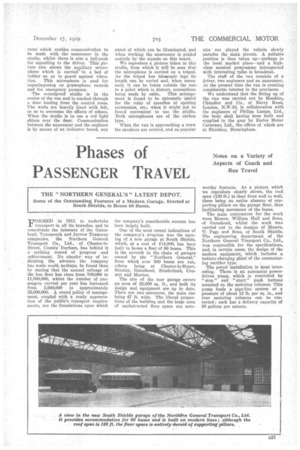A Remarkable RADIO Demonstration VAN
Page 58

Page 59

If you've noticed an error in this article please click here to report it so we can fix it.
A Dennis Passenger Chassis Forms the Basis of a Most Interesting Van Which Has Been Built and Equipped to Perform an Unique Service.
ONE of the most remarkable demonstration motorvans ever placed on the road is surely that which has recently been commissioned for service by Philips Lamps, Ltd., 145, Charing .cross Road, London, W.C.2. It is
. unique m many ways, but certainly by reason of the nature. and extent of the equipment which is accommodated.
For Some time past the engineers of the company have been devoting attention to the design of such a van, and many weeks of experimenting had to be undertaken before the vehicle was considered to be suitable to take the road. The basis of the van is a Dennis forward-control bus 'chassis, and the well-equipped body which it carries is divided into five distinct sections, these
being the driver's, cab, engine • room, soundproof studio, control room and display windows.
On the roof of the van two aerial masts and loudspeakers are carried, but these are collapsable, and when a long journey has to be undertaken between towns in which demonstrations have been planned, they lie fiat on the roof, to which a small hatchway from the ,control room gives easy access..
All the necessary power is generated by an alternator driven by a petrol en7 gine, and in the section in which this is accommodated is a small rotary coi“ verter. The alternator is rated at 4 kw., half of which is used for window lighting. As our illustration of the complete van clearly shows, the display windows serve to draw attention to a variety of Philips products, and at
c36 night they present a striking appearance with their backgrounds of shimmering . gold. The remaining 2 kw., after passing through the main fuses and switchboards in the engine room, are passed to the control room and fed to the main antplifier.
This amplifier is a remarkable piece of mechanism. Rated at 600 watts, it comprises a rectifying valv.e carrying a
potential of 8,000 volts. The single transmitting valve has a filament as thiLek as a lead pencil, and it carries a voltage of 4,000 on its anode, which is, of course, necessary to provide the high
anode dissipation. The amplifier is entirely foolproof and no person can obtain the least shock from it; if an attempt be made to open the grille all power would at once be cut off. When operating, the transmission is checked by meters.
To the left of the main amplifier, which occupies a prominent place in one of the pictures which we reproduce, can be seen a gramophone turntable, and immediately to the right is another amplifier. This is the gramophone microphone amplifier, which is auxiliary to the main one and governs , the microphone and gramophone Pick-up output ,when records are being relayed. A little farther along is a receiving set with its lead-in from the outside aerial. When distant stations are being received the output of this receiver is fed direct into. the main amplifier and then to the Speakers mounted on the roof.
Above this set is the electrical signalling equip
meet which enables communication to be made with the announcer in the studio, whilst there is also a bell-push for signalling to the driver. This picture also shows the auxiliary, microphone which is carried in a bed of rubber se as to guard against vibration. This microphone is used for superimposing on gramophone records and for emergency purposes.
The soundproof studio is in the centre of the van and is reached through a door leading from the control room. The walls are heavily lined with felt, so as to overcome the effects of echoes, When the studio is in use a red light shines over the door. Communication between the announcer and the engineer is by means of an indicator board, any panel of which can be illuminated, and when working the announcer is guided entirely by the signals on this hoard.
We reproduce a picture taken in this studio, from which it will be seen that the microphone is carried on a tripod. As the tripod has telescopic legs its length can be varied and, when necessary, it can be taken outside the van to a point which is distant, connections
being made by cable. This arrangement is found to be egremely useful for the relay of speeches at opening ceremonies, etc., when it might not be found convenient to use the studio. Both microphones are of the carbon type.
When the van is approaching a town the speakers are ereeted, and as popular airs " are played the vehicle slowly Parades the main streets. A suitable position is then taken up—perhaps in the local market place—and a highclass musical programme interspersed with interesting talks is broadcast.
The staff of the van consists of a driver, two engineers and an announcer. At the present time the van is creating considerable interest in the provinces.
We understand that the fitting up of the van was carried out by Manhire, Chandler and Co., of Barry Road, London, N.W.10, in collaboration with the engineers of Philips Lamps, Ltd., the body shell having been built and supplied in the grey by Eccles Motor Caravans, Ltd„ the offices of which are at Stirchley, Birmingham,












































































































